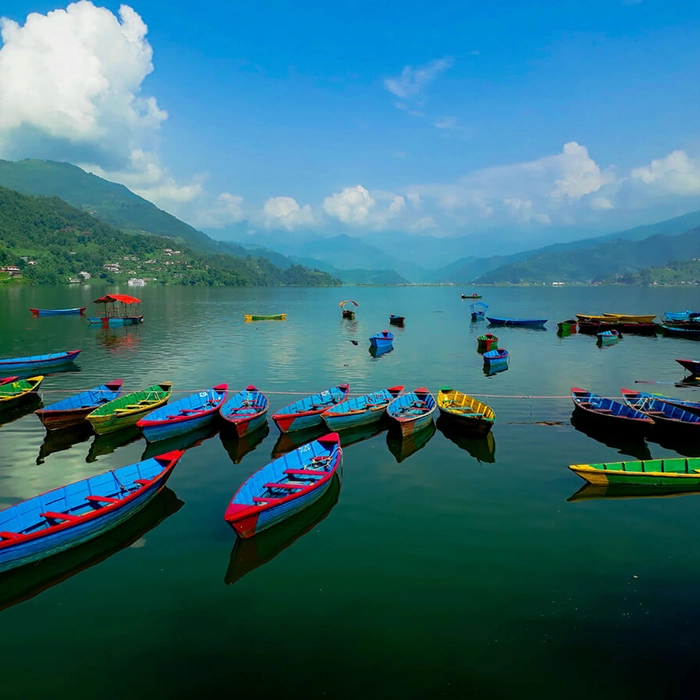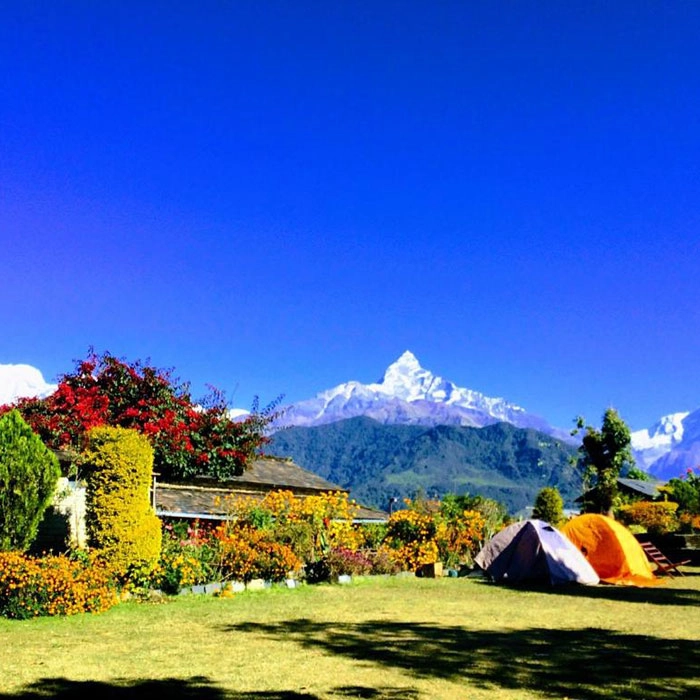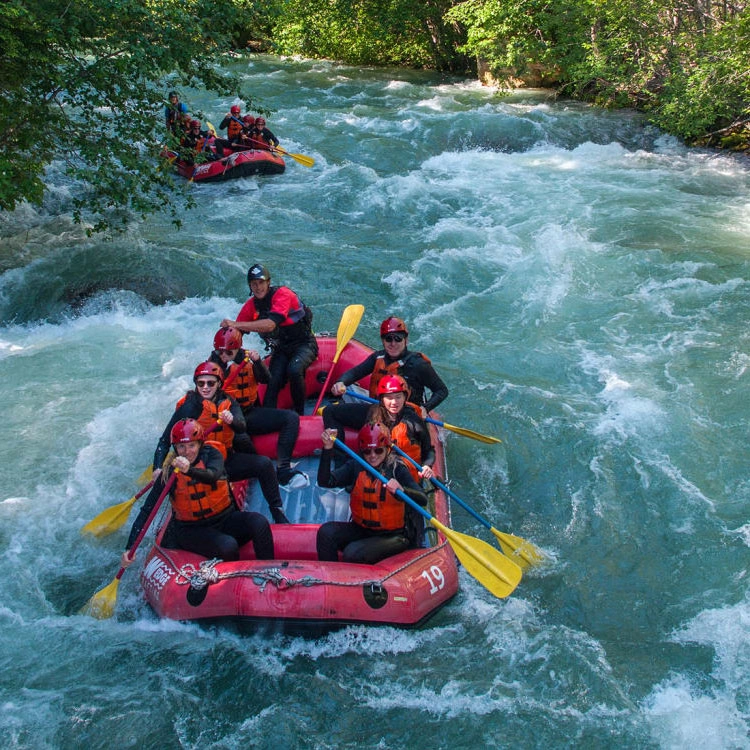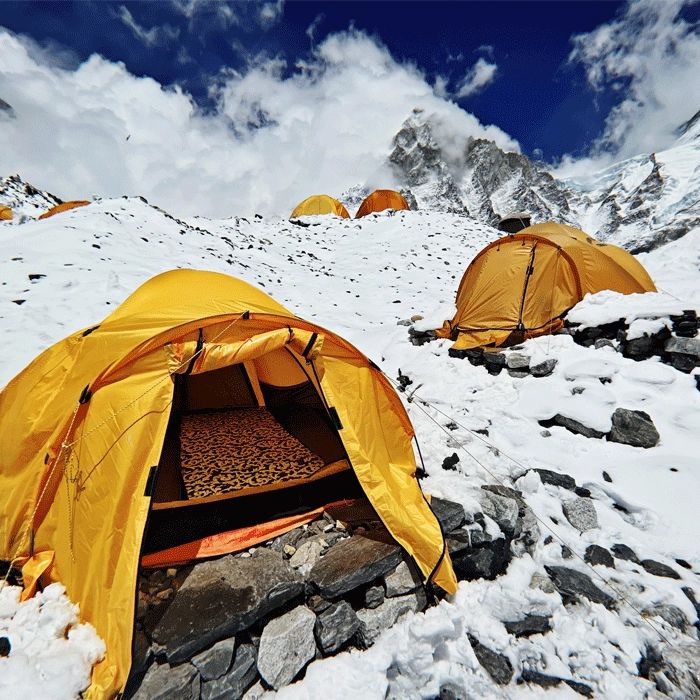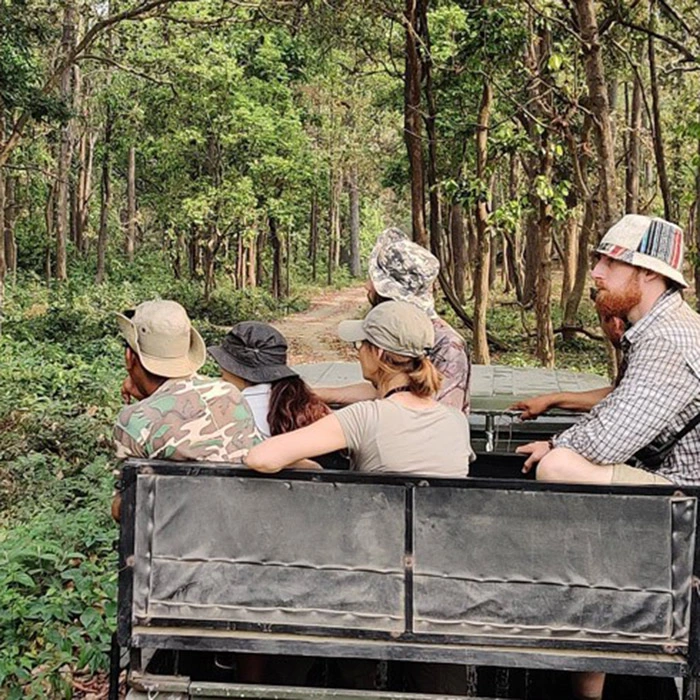ISLAND PEAK EXPEDITION
US$3,240.00
/pp
-
18 Days
-
Everest
-
Spring/Autumn
-
Trek & Climb
-
6,190 Meters
-
Strenuous
-
Car / Plane
-
02-16 People
-
JH#231
 Overviews
Overviews
Island Peak Expedition Journey BeginsIsland Peak Expedition journey starts from Kathmandu, the capital of the Himalayan state “Nepal,” where you will explore the city in your spare time before trek. The Island Peak Expedition is also known as Island Peak Climbing. Island Peak (6,190 m) offers a lifelong adventure, fulfilling dreams that soar beyond the clouds. Everest, the highest mountain in the world, is known as Sagarmatha in Nepalese and Chomolungma in Tibetan. On the way to Everest Base Camp, the views of the surrounding peaks are stunning. Mount Ama Dablam, Lhotse, Nuptse, and Mt. Everest serve as constant companions throughout this rewarding trek. Scenic HighlightsAs we trek, we’ll enjoy breathtaking panoramic views of Mount Ama Dablam, Lhotse, and Nuptse throughout our journey. On the return trip to Lukla, we will walk from Dingboche to Ama Dablam Base Camp (4,600 meters). Hiking at the foot of the world’s highest mountain is an exhilarating experience for adventure lovers. Among the many attractions of this Island Peak Expedition trek is the satisfaction of reaching the base of Everest. Along the way, you will support local economies and discover the strength within you. You will also make friends and create memories that will last a lifetime. So, what are you waiting for? Join us now in this Island Peak Expedition and make lifelong memories! Exploring KathmanduOnce you’ve absorbed the stunning beauty of Everest Base Camp, your adventure wraps up as you head back to Lukla for a brief flight to Kathmandu. In Kathmandu, we recommend taking a rest day to explore incredible sites, especially if it’s your first visit to Nepal. The old royal city of Bhaktapur Durbar, the Buddhist stupa of Bouddhanath, and the Hindu temple of Pashupatinath are must-see attractions. Each location offers a glimpse into the rich cultural heritage and spiritual essence of Nepal. Continuing the Island Peak Expedition AdventureYour Island Peak Expedition adventure doesn’t just end with the trek; it continues in the heart of Kathmandu. In Kathmandu, immerse yourself in the lively local culture, indulge in flavorful Nepali dishes, and hunt for distinctive souvenirs. Interacting with locals will enhance your understanding and appreciation of their rich traditions and lifestyle. Whether you’re strolling through ancient streets or enjoying a meal with a view of the mountains, each moment in this beautiful country adds to the richness of your Island Peak Expedition journey. Island Peak Expedition DifficultyThe Island Peak Expedition is considered a moderately technical and physically demanding climb, best suited for trekkers with prior high-altitude experience and basic mountaineering skills. Standing at 6,190 meters (20,305 ft), Island Peak involves glacier travel, use of fixed ropes, and steep snow/ice slopes, especially near the summit ridge. Climbers typically trek for several days to acclimatize, following the Everest Base Camp or Chhukung route, before attempting the summit. The ascent day is long and strenuous, requiring 8–12 hours of continuous effort. While not as technical as other Himalayan peaks, Island Peak still requires crampon use, rope handling, and a good level of fitness and mental endurance. With professional guidance and proper acclimatization, it is a rewarding stepping stone into the world of Himalayan mountaineering. Island Peak CostThe Island Peak Expedition cost typically includes essential services such as a licensed climbing guide, porter support, Everest Region permits, climbing permits for Island Peak, camping or teahouse accommodations, all meals during the trek and climb, and ice gear (crampons, ice axe, harness, ropes). It also covers ground and/or domestic flight transportation to and from the trailhead (usually via Lukla). Solo climbers receive personalized assistance, while groups benefit from tiered pricing, with per-person rates decreasing as group size increases. We also offer seasonal promotions during quieter climbing seasons to make this exhilarating high-altitude adventure more accessible. While our website displays standard international rates, you’re invited to contact us directly for private-group quotes, where we promise the most competitive price without compromising on safety, climbing gear quality, or service standards.
 Itinerary (Plan)
Itinerary (Plan)
Arrive in Kathmandu, Nepal's vibrant capital, where you'll be warmly welcomed with marigold garlands. After transferring to your hotel, take time to relax and acclimate to the bustling city. Discover vibrant local markets, indulge in traditional Nepali dishes, and delve into Kathmandu's rich cultural tapestry. This initial day is perfect for easing into your journey, setting the stage for the exciting adventures ahead in Eastern Nepal. A representative from Jagadamba Holidays will ensure a smooth and pleasant arrival.
Optional Evening Activity:
If you wish, you can spend your evening experiencing the Pashupatinath Aarti, a captivating religious ceremony held at the Pashupatinath Temple. The Aarti usually begins around 6:00 PM and lasts for approximately an hour. This ceremony is a mesmerizing display of traditional music and rituals, providing a profound insight into Hindu spiritual practices. Please check the exact time for the Aarti on the day of your visit, as it may vary. This option is not included in the standard itinerary but offers a unique opportunity to immerse yourself in local culture.
Normally, we book a flight from Kathmandu to Lukla (2,846 m / 9,350 ft.); however, if we are unable to secure a direct flight for some reason, we will need to take an alternative flight option via Ramechhap. If our flight to Lukla is scheduled from Manthali and we have extra time, we will explore the Kathmandu Valley before driving to Manthali for an overnight stay. However, if time is limited, we will depart from Kathmandu at 2 AM to catch the flight on Day 2. This will take approximately four hours to cover the distance of 132 kilometers to Manthali.
This early departure ensures that we arrive in time for the first flight from Ramechhap to Lukla, which departs at 6:30 AM. We will leave Kathmandu according to our scheduled departure time to guarantee a smooth journey to the airport.
Upon arrival at Lukla, your guide will introduce you to your porter. After a brief tea break, we will commence our trek to Phakding (2,620 m / 8,595 ft.). Phakding, a picturesque village and the largest settlement in the area, serves as an ideal first stop for many trekkers spending their initial night in the mountains. Once you arrive in Phakding, you'll enjoy a one-hour break to relax and take in the stunning surroundings. It is recommended to meet with your guide in the lobby afterward to discuss the evening's activities and the schedule for the following day.
Following your refreshment break at Lukla, embark on your trek to Phakding, traversing the scenic route through Nurning Ghat (2,590 m). The trek covers about 8.5 kilometers and takes approximately 3 to 4 hours. During this journey, you will ascend 190 meters and descend 380 meters.
After your breakfast at the lodge, embark on your trek to Namche Bazaar (3,440 m / 11,286 ft.), traversing the scenic route through Monjo (2,835 m). The trek covers about 9.5 kilometers and takes approximately 5 to 6 hours. During this journey, you will ascend 860 meters and descend 190 meters.
We embark on a picturesque trek in the Khumbu region along the Dudh Koshi River. Here, we'll cross stunning suspension bridges adorned with colorful prayer flags. As we navigate the trail, we pass through charming Sherpa villages and lush rhododendron forests, steadily ascending while soaking in breathtaking views of majestic snow-capped peaks.
This journey offers both beauty and challenge, making every step worthwhile. Upon reaching Namche Bazaar (3,440 m / 11,286 ft.), the largest Sherpa village and a vital trading hub, we’ll have ample opportunity to acclimatize to the altitude.
Namche Bazaar's vibrant market is bustling with shops, cafes, and bakeries, creating a lively atmosphere against the dramatic Himalayan backdrop. After checking into our lodge, you can relax, hydrate, and enjoy a warm meal. In the evening, we’ll gather with our group to share stories and reflect on the day’s adventures, setting the stage for an exciting acclimatization day ahead.
This trek from Phakding to Namche Bazaar not only showcases stunning vistas but also immerses you in the rich Sherpa culture, making it a memorable part of your Everest Base Camp journey.
Make the most of your rest day in Namche Bazaar by acclimatizing to the altitude and immersing yourself in the stunning beauty of the Khumbu region. After a hearty breakfast, you can either explore the vibrant town of Namche or embark on an optional scenic trek to Khunde, passing through Khumjung village, with a stop at the renowned Everest View Hotel (3,880 m / 12,730 ft.).
This picturesque hike to Khunde offers breathtaking views of the world’s tallest peaks, including Mount Everest, Lhotse, and Ama Dablam. The well-marked trail is relatively steep, rewarding trekkers with panoramic vistas and ample opportunities for memorable photographs. At the Everest View Hotel, take a moment to pause for refreshments while soaking in the magnificent surroundings before continuing your journey to Khunde, a charming Sherpa village rich in culture and history.
Once in Khunde, explore local attractions such as the Sherpa museum and historic monasteries, which showcase the unique heritage of the Sherpa people. After your trek, return to Namche Bazaar for a leisurely lunch and some free time to visit local shops, purchase trekking gear, or unwind at a cozy café with stunning mountain views.
In the evening, gather with your group to share stories from your day and enjoy a warm meal together. This day of exploration and acclimatization not only enriches your experience in the Himalayas but also prepares you for the exciting adventures that lie ahead.
The round-trip trek from Namche Bazaar to Khunde via the Everest View Hotel and Khumjung covers approximately 8.15 kilometers and typically takes 5 to 6 hours. During the journey, you will ascend 550 meters and descend 550 meters.
After enjoying breakfast at the lodge, set out on your scenic trek to Phortse, navigating the breathtaking route through Mong La (3,975 m), known for its panoramic views of the majestic Himalayas. The trek covers about 10.5 kilometers and takes approximately 5 to 6 hours. During this journey, you will ascend 790 meters and descend 400 meters.
The journey to Phortse takes you on a scenic trek, crossing over Mong La (3,975 m / 13,041 ft.), a breathtaking viewpoint offering panoramic views of the Himalayas. As you climb higher, you’ll be rewarded with spectacular sights of Mount Ama Dablam, Thamserku, and Kangtega, along with distant peaks like Everest and Lhotse. The trail winds through dense rhododendron and juniper forests, which in spring bloom into a vibrant display of colors.
Upon reaching Mong La, the view becomes even more expansive, revealing stunning vistas of the Dudh Koshi River valley and snow-capped mountains all around. Take a moment to rest and capture photos of this awe-inspiring landscape. From Mong La, the path sharply descends into the lush valley of Phortse Tenga, followed by a steady ascent that leads you to the authentic Sherpa village of Phortse, known for its rich cultural heritage.
Phortse, located at an altitude of around 3,810 meters (12,500 ft.), is one of the lesser-frequented villages on the Everest trekking route, offering a more authentic glimpse into Sherpa culture. The terraced fields and traditional stone houses present a peaceful contrast to the more commercialized areas along the trail. As you approach Phortse, enjoy the views of Phortse Gompa, an ancient monastery perched above the village.
Upon arrival, settle into your lodge, where you can relax and soak in the tranquility of this remote mountain setting. In the evening, take a stroll through the village, meet locals, or simply unwind as you gaze out at the surrounding peaks, reflecting on the beauty and challenges of today’s trek. Today’s trek offers a remarkable experience, combining breathtaking mountain scenery with deep insights into the traditional Sherpa way of life, leaving you with lasting memories.
After enjoying breakfast at the lodge, begin your scenic trek to Dingboche, passing through the picturesque village of Pangboche (3,985 m / 13,074 ft.), renowned for its stunning views and rich Sherpa culture. The trek covers about 12 kilometers and takes approximately 6 to 7 hours. During this journey, you will ascend 690 meters and descend 190 meters.
The trek from Phortse to Dingboche is a captivating journey through the heart of the Khumbu region, offering stunning mountain views and an unforgettable experience of high-altitude trekking. After breakfast, set out from the peaceful village of Phortse, following a trail that meanders along the hillside, providing panoramic vistas of iconic peaks such as Ama Dablam, Lhotse, and Taboche. As you trek through rhododendron and juniper forests, you may also spot wildlife like Himalayan tahr and colorful pheasants.
The path gradually ascends, offering a perfect blend of serenity and natural beauty. Along the way, you will cross suspension bridges over glacial rivers and pass through small Sherpa settlements, where you can observe traditional lifestyles. The journey becomes more rugged as you approach the Imja Valley, with towering peaks surrounding you at every turn.
Upon reaching Dingboche, situated at an elevation of 4,410 meters (14,469 ft.), you’ll be greeted by vast open fields and the majestic backdrop of Ama Dablam. Dingboche, known as the "summer valley," is a popular stop for trekkers heading to Everest Base Camp due to its stunning location and ample facilities. After checking into your lodge, take some time to relax and acclimatize to the altitude, enjoying the peaceful ambiance of the village.
In the evening, as the sun sets behind the mountains, you can gather with your group to share stories of the day’s adventures and prepare for the challenges that lie ahead on your trek to Everest Base Camp. This day offers a perfect balance of scenic beauty and cultural discovery, leaving you with unforgettable memories of the Himalayas.
Today is dedicated to acclimatization, allowing your body to adjust to the altitude and preparing you for the trekking challenges ahead. After a hearty breakfast at your lodge, set out on a short hike to Nangkar Tshang, a beautiful vantage point that offers breathtaking views of the surrounding peaks, including Ama Dablam and Lhotse.
The trek to Nangkar Tshang, situated at an altitude of approximately (5,040 m / 16,535 ft.) meters, is a rewarding experience, with the trail winding through lush meadows and rocky terrain. As you ascend, take your time to soak in the serene beauty of the Khumbu region. The panoramic vistas from the top are simply spectacular, providing ample opportunities for stunning photographs. This picturesque setting is a perfect place to reflect on your journey thus far and appreciate the majestic Himalayas that envelop you.
Upon your return to Dingboche, spend the remainder of the day relaxing and hydrating. Use this time to connect with fellow trekkers, share stories and experiences, and discuss the challenges and triumphs of the journey. Engaging with your group fosters camaraderie and enhances the overall experience.
In the afternoon, take leisurely strolls through the village of Dingboche, visiting local tea houses and observing the unique Sherpa culture. The calm atmosphere and breathtaking scenery create a perfect environment for relaxation. As the sun begins to set, gather for dinner at your lodge, celebrating the progress you’ve made and the friendships formed along the way. This acclimatization day not only prepares you for the adventures ahead but also enriches your experience in the heart of the Himalayas, leaving you with lasting memories.
The round-trip trek from Dingboche to Nangkar Tshang covers approximately 4.85 kilometers and typically takes 4 to 5 hours. During the journey, you will ascend 650 meters and descend 650 meters.
After breakfast at the lodge, embark on your trek to Lobuche (4,940 m), traversing the scenic route through Thukla Pass (4,830 m). The trek covers approximately 8 kilometers and takes about 4 to 5 hours. During this journey, you will ascend 600 meters and descend 20 meters.
The trek from Dingboche takes you through the rugged beauty of the Khumbu region, surrounded by towering peaks and vast glacial valleys. The ascent takes you along rocky trails, gradually leading into more barren yet dramatic landscapes as the mountains rise closer and the air becomes thinner. The trail leads to Thukla Pass (4,830 m), a solemn point along the route where memorials honor the climbers who lost their lives on Everest and nearby peaks. These memorials, set against the stunning backdrop of the Himalayas, create a reflective moment, adding a deeper connection to the trek as you silently pay tribute to these adventurers.
Beyond Thukla Pass, the path becomes steeper and more challenging as you approach Lobuche (4,940 m / 16,207 ft.), a small settlement nestled in the shadows of some of the world’s highest mountains, including Pumori and Nuptse. The crisp air, combined with awe-inspiring vistas of these towering peaks, fuels your determination as you draw closer to your destination.
Upon arrival in Lobuche, settle into your lodge to rest, hydrate, and refuel with a hearty meal. The quiet atmosphere of this remote village provides a peaceful space to reflect on the day’s trek and prepare for the upcoming adventure to Everest Base Camp. Gather with fellow trekkers in the evening, sharing stories and anticipation as you near the final leg of your journey.
After breakfast at the lodge, embark on your trek to Gorak Shep (5,140 m / 16,864 ft.). After checking into the lodge, begin an exploratory hike to Everest Base Camp (5,364 m / 17,598 ft.). The total trek covers approximately 14 kilometers and takes about 7 to 8 hours. During this journey, you will ascend 424 meters and descend 224 meters.
Today represents the pinnacle of your Himalayan journey—the remarkable trek to Everest Base Camp! Set off with excitement and anticipation, ready to conquer one of the world’s most iconic trekking destinations in the majestic Himalayas, and embrace the spirit of mountain adventure and adventure travel. The trail to Everest Base Camp presents a challenging journey as you navigate rocky moraines and rugged glacial terrain, but the awe-inspiring views make every step worthwhile.
As you trek closer to Base Camp, the landscape transforms into a breathtaking display of natural beauty. The Khumbu Glacier stretches out before you, surrounded by towering peaks that watch over your ascent. The atmosphere is alive with the energy of fellow trekkers, all sharing in the thrill of reaching this remarkable destination. After approximately 7 to 8 hours of trekking, you will finally arrive at Everest Base Camp (5,364 m), a significant milestone for adventurers from around the globe.
Take time to immerse yourself in the incredible atmosphere and capture stunning photographs of this unforgettable experience. The sight of vibrant tents set against the stunning backdrop of Mount Everest will create lasting memories you'll cherish for a lifetime. Celebrate this remarkable achievement with your fellow trekkers, sharing stories and laughter that will bond you for life.
After enjoying your time at Base Camp, begin your descent back to Gorak Shep, where you’ll check into your lodge for the night. Reflect on your incredible journey over a warm meal, preparing for the next leg of your adventure in the majestic Himalayas. This day is more than just a trek; it’s a celebration of determination, friendship, and the unparalleled beauty of nature.
Start your day with an early morning hike to Kala Patthar (5,550 m / 18,209 ft.), where you'll be rewarded with breathtaking sunrise views over the majestic Himalayas. After enjoying the stunning panorama, return to Gorak Shep for a hearty breakfast to fuel your next adventure.
Following breakfast, set out on your trek to Dingboche, taking the scenic route through Lobuche and the iconic Thukla Pass (4,830 m). The trek covers about 16 kilometers (including Kala Patthar) and takes approximately 8 to 9 hours. During this journey, you will ascend 450 meters and descend 1,270 meters.
As you ascend, anticipation builds for the awe-inspiring sunrise that awaits you at this elevated vantage point. Reaching Kala Patthar (5,550 m) in the pre-dawn hours, you'll be rewarded with a stunning display of colors as the sun rises over the towering peaks, including the magnificent Mount Everest. This moment is truly unforgettable, offering a perfect opportunity for breathtaking photographs and personal reflection amid the natural beauty of the world's highest mountains.
After enjoying the breathtaking views and embracing the tranquil ambiance, make your way back to Gorak Shep, where a nourishing breakfast awaits to replenish your strength. Enjoy a warm meal as you discuss the day's plans with fellow trekkers, sharing stories and experiences that highlight the unique aspects of this adventure travel journey.
Following breakfast, set out on your trek to Dingboche, traversing the scenic route that winds through the picturesque landscapes of Lobuche and the iconic Thukla Pass (4,830 m). During your trek, you'll navigate through rugged trails, glacial valleys, and the stunning landscapes that make the Himalayas a world-renowned destination for adventure seekers. The combination of physical challenge and visual splendor makes this trek a truly remarkable adventure.
Upon reaching Dingboche, you can relax in this charming village, known for its stunning views and warm hospitality. Reflect on your journey, surrounded by the majestic mountains, and prepare for the next leg of your Himalayan adventure. The experiences and memories from this unforgettable sunrise at Kala Patthar and the trek to Dingboche will stay with you long after your journey concludes.
After breakfast at the lodge, embark on your trek to Island Peak Base Camp (5,100 m / 16,732 ft) via the scenic route through Chukhung (4,750 m / 15,584 ft), where peaceful landscapes and a sense of adventure await. This day's trek covers approximately 11 kilometers and typically takes 8 to 9 hours. Along the journey, you will ascend 800 meters and descend 20 meters, with the trail offering a blend of alpine terrain and stunning mountain vistas.
The trail from Dingboche to Chukhung showcases dramatic views of towering peaks like Lhotse and Ama Dablam, drawing you closer to Nepal's mountainous heart. As you progress, the terrain becomes increasingly rugged, adding a thrill to the journey. A brief rest in Chukhung offers a chance to recharge and absorb the breathtaking scenery before you continue towards Island Peak Base Camp. Surrounded by glacial moraines and towering summits, this base camp is an ideal spot to acclimate, preparing both mind and body for tomorrow's ascent to Island Peak's iconic summit. It's a captivating experience that offers trekkers the perfect base for exploring one of the Himalayas' most revered climbing routes.
As you settle into camp, the surrounding peaks create an awe-inspiring atmosphere, setting the stage for tomorrow's ascent. The area around the base camp is known for its rich geological features, with glacial rivers and ice formations creating a unique landscape against the backdrop of Himalayan giants. The peace of the campsite, combined with the grandeur of the peaks, offers a moment to reflect and mentally prepare for the challenge ahead, making Island Peak Base Camp a memorable highlight of your trek.
Today marks the primary goal of your expedition: the summit of Island Peak (6,190 m / 20,305 ft), a truly exhilarating achievement in the Everest region. This challenging trek spans approximately 13 kilometers and generally takes 10 to 11 hours to complete. Throughout this journey, you will ascend 980 meters and descend 1,370 meters, navigating diverse terrain that includes rugged alpine landscapes and breathtaking mountain vistas.
The summit attempt begins in the early hours, with headlamps lighting the way as you make your approach. The ascent presents a mix of steep trails, ice fields, and rocky climbs, requiring careful pacing and focus. The final stretch involves technical rock-and-ice climbing, where ropes are essential to safely navigate the narrow ridges. As you reach the peak, the sweeping panorama of the Everest region awaits, featuring majestic views of Lhotse, Nuptse, and Makalu. This moment captures the spirit of Himalayan trekking, offering an incredible sense of accomplishment.
After taking in the remarkable views from the summit, you begin the descent back to Chukhung (4,750 m / 15,584 ft). The journey down reveals new perspectives on the surrounding landscapes, allowing you to appreciate the vastness of the glacial terrain and the intricate paths carved into the mountainside. Upon reaching Chukhung, you can relax and share stories with fellow trekkers, relishing the warmth of the lodge and the camaraderie of others who share in this unforgettable achievement.
After breakfast at the lodge, begin your trek from Chhukhung towards the renowned Tengboche Monastery (3,860 m / 12,664 ft). This scenic journey covers approximately 15.2 kilometers and typically takes 6 to 7 hours to complete. Throughout this trek, you will ascend 150 meters and descend 1,020 meters, offering a blend of rugged alpine landscapes and breathtaking mountain vistas.
As you navigate this route, you will pass through the charming villages of Dingboche and Pangboche, where you can experience the vibrant local culture and warm hospitality of the Sherpa people. The trek features diverse terrain, transitioning from high alpine paths to lush rhododendron forests, all while enjoying panoramic views of iconic peaks such as Ama Dablam and Everest.
Upon reaching Tengboche, you will encounter the famous Tengboche Monastery, a significant spiritual center that provides insight into the rich Buddhist culture of the region. The monastery, set against a backdrop of majestic mountains, offers a serene atmosphere for contemplation and appreciation of the surrounding beauty. This day not only highlights the natural wonders of the Everest region but also deepens your connection to its cultural heritage, making for an unforgettable trekking experience.
In Tengboche, take time to explore the monastery, one of the most sacred sites for Buddhist practitioners in the region. The surrounding area exudes a profound sense of peace, with prayer flags fluttering in the breeze and the distant sound of chants echoing through the mountains. Spending the evening here, surrounded by ancient spiritual practices and the Himalayas' quiet grandeur, brings a reflective close to your journey.
After breakfast at the lodge, embark on your trek to Monjo (2,835 m / 9,301 ft.), traversing the scenic route through Kyangjuma (3,600 m / 11,811 ft.). The trek covers about 15.5 kilometers and takes approximately 6 to 7 hours. During this journey, you will ascend 400 meters and descend 1,450 meters.
As you set out from Tengboche Monastery, the trail takes you through pristine forests of rhododendron and pine, offering breathtaking views of the surrounding snow-capped peaks. The tranquility of the mountains, combined with the vibrant prayer flags fluttering in the wind, creates a spiritual atmosphere that perfectly complements your journey. Along the trail, you will journey through the picturesque village of Kyangjuma, a spot renowned for its sweeping vistas of towering Himalayan giants like Ama Dablam, Everest, and Lhotse. The panoramic scenery here is truly captivating, offering an ideal pause for trekkers to soak in the grandeur of the surrounding peaks.
The descent towards Monjo leads you through scenic river valleys and over suspension bridges that cross the mighty Dudh Koshi River. You’ll encounter traditional Sherpa villages along the way, where the locals greet you with warm smiles and a glimpse into their unique culture. The landscape transitions from high alpine terrain to lush green valleys as you make your way down, showcasing the diversity of the region’s natural beauty.
Upon reaching Monjo, a peaceful village nestled in the Dudh Koshi Valley, you can relax and reflect on the day's journey. Monjo, located at the gateway to Sagarmatha National Park, provides a peaceful and relaxing atmosphere after a long day’s trek. Nestled in the tranquil Dudh Koshi Valley, it serves as a quiet retreat where you can unwind and reflect on the day’s adventures while surrounded by nature’s beauty. Take the time to unwind, appreciate the surrounding views, and prepare for the final stages of your Himalayan adventure.
After breakfast at the lodge, embark on your trek to Lukla (2,846 m / 9,350 ft.), traversing the scenic route through Phakding (2,610 m). The trek journey covers about 12.5 kilometers and takes approximately 4 to 5 hours. During this journey, you will ascend 410 meters and descend 330 meters.
As you set off from Monjo, the trail meanders alongside the rushing waters of the Dudh Koshi River, providing a soothing soundtrack to your adventure. The stunning scenery is adorned with colorful rhododendron forests, rich greenery, and quaint traditional villages, creating a vibrant tapestry that enhances your trekking experience. Watch for local wildlife along the way, such as vibrant birds and mischievous monkeys, as you traverse this captivating landscape.
The journey to Lukla offers more than just reaching your destination; it provides a chance to delve into the rich Sherpa culture that flourishes in this enchanting region. You may encounter friendly locals along the way, offering warm smiles and greetings that enhance your trekking experience. Take the time to appreciate the intricate carvings and prayer flags adorning the monasteries that line the path, which serve as a reminder of the spiritual significance of this region.
As you approach Lukla, the bustling atmosphere of this gateway town comes into view. Known for its famous airport, Lukla serves as the starting point for many trekkers heading into the Everest region. Upon arrival, enjoy a moment to relax and reflect on your journey while soaking in the views of the surrounding peaks.
This trek concludes with a sense of accomplishment and anticipation for the adventures that lie ahead in the majestic Himalayas. Whether you are an experienced trekker or a novice explorer, the journey from Monjo to Lukla through Nurning offers a memorable experience filled with breathtaking landscapes and cultural insights.
After an unforgettable journey through the breathtaking landscapes of the Everest region, it's time to conclude your adventure with a scenic return flight from Lukla to Kathmandu. This flight is not only a means of transportation but also an extension of your Himalayan experience, offering stunning aerial views that will leave you in awe.
As you board the small aircraft, the excitement builds for the final leg of your trek. The flight from Lukla, known for its challenging runway, will take you on a thrilling journey above the majestic mountains you’ve spent days trekking through. As the plane ascends, you'll be treated to panoramic views of the rugged Himalayan terrain, including towering peaks and deep valleys. On a clear day, you might catch glimpses of some of the world’s highest mountains, including Lhotse, Makalu, and, of course, the iconic Mount Everest.
The flight typically lasts about 30 to 40 minutes, providing ample time to soak in the breathtaking scenery. The pilot often maneuvers the plane in a way that allows passengers to see both sides, so be sure to have your camera ready. The vibrant colors of the landscapes below contrast beautifully with the stark whites of the snow-capped peaks, creating a stunning visual tapestry.
Upon arriving at Tribhuvan Domestic Airport, you will be welcomed back to the vibrant city of Kathmandu, where the lively atmosphere and rich culture await your exploration. The transition from the serene mountains to the vibrant energy of the capital is a reminder of the diverse experiences Nepal offers. After collecting your luggage and possibly sharing stories with fellow trekkers, you’ll have the opportunity to explore the rich cultural heritage, delicious cuisine, and lively markets of Kathmandu.
This return flight not only marks the end of your trek but also serves as a perfect conclusion to an adventure filled with breathtaking landscapes, cultural encounters, and personal reflections. Cherish the memories you’ve created in the heart of the Himalayas, as they will stay with you long after your journey concludes.
The buffer day in Kathmandu serves as a crucial safety net during your trekking adventure in the Himalayas. Given the unpredictable nature of mountain weather and the potential for flight delays, this day is designed to ensure a smooth travel experience. By including a buffer day in your itinerary, you can mitigate the impact of unforeseen circumstances and allow for a more relaxed journey.
If your flights operate as scheduled and weather conditions are favorable, this day offers a fantastic opportunity to explore the rich cultural and historical tapestry of the Kathmandu Valley. The valley is a UNESCO World Heritage Site, home to seven remarkable monument zones, each showcasing unique aspects of Nepalese culture and heritage.
You can begin your exploration in the heart of Kathmandu at Durbar Square, where ancient palaces, temples, and courtyards tell the story of the city's royal history. Marvel at the intricately carved architecture of Kastamandap and Kasthamandap Temple, and don’t miss the iconic Kumari Ghar, the residence of the living goddess, or Kumari.
Next, consider visiting Swayambhunath, also known as the Monkey Temple, perched atop a hill overlooking the valley. This ancient stupa is adorned with colorful prayer flags and offers panoramic views of the city and surrounding mountains. The site is also home to many monkeys, adding a playful element to your visit.
For a more spiritual experience, you can head to Boudhanath Stupa, one of the largest stupas in the world. This sacred site is a significant pilgrimage destination for Buddhists and features a bustling marketplace filled with traditional shops and eateries. Here, you can observe the rituals of local monks and engage with the community while enjoying a delicious bowl of traditional Nepali dal bhat.
If you have time, a trip to Pashupatinath Temple, one of the holiest Hindu temples in the world, is a must. Situated along the banks of the Bagmati River, this temple complex is a hub of religious activity, where you can witness traditional cremation ceremonies and explore the serene surroundings.
Throughout your day of exploration, immerse yourself in the vibrant local culture, indulge in delectable street food, and engage with the friendly locals. This buffer day not only acts as a precautionary measure for travel disruptions but also enhances your overall experience in Nepal, allowing you to discover the breathtaking beauty and rich history of the Kathmandu Valley. Whether your journey is uninterrupted or you need to utilize this day for adjustments, it promises to be a memorable addition to your adventure in the Himalayas.
Concluding Your Journey in Nepal
As your remarkable journey through the Himalayas comes to an end, take a moment to reflect on the awe-inspiring natural beauty, rich cultural heritage, and memorable experiences that have defined your time in Nepal. From the majestic mountain landscapes to the warm hospitality of the local communities, every moment has contributed to an unforgettable adventure.
Airport Transfer by Jagadamba Holidays
To ensure a smooth and timely departure, an official representative from Jagadamba Holidays will collect you from your hotel 3.5 hours prior to your scheduled flight departure. Our team is committed to providing a reliable and comfortable transfer service to Tribhuvan International Airport, allowing you to conclude your journey with peace of mind.
We sincerely appreciate your trust in Jagadamba Holidays and hope to have the pleasure of serving you again on your future journeys.
Quotation 2025
| Group Size (Pax) |
2 - 2 |
3 - 4 |
5 - 6 |
7 - 8 |
9 - 12 |
13 - 16 |
17 - 20 |
21 - 24 |
25 - 32 |
| Cost Per Person |
$2,916 |
$2,866 |
$2,816 |
$2,766 |
$2,716 |
$2,666 |
$2,616 |
$2,566 |
$2,516 |
 Cost Include
Cost Include
- All transfers within Nepal are included as per itinerary
- Any domestic flight of Nepal as per trekking itinerary
- Trekking accommodation (hotel, lodge and/or tent) as per itinerary
- Small shared room with shared bathroom during trek in Nepal
- In Kathmandu and/or Pokhara: Stay at ***Hotel with breakfast
- Luggage for porters during the trek (12.5 kg/person)
- Enjoy unlimited breakfast, lunch, and dinner throughout the trek.
- Unlimited tea or coffee for breakfast during the trek
- An English speaking guide (trekking/tour) as per Itinerary
- Travel insurance for trekking staff (guides and porters)
- All expenses of trekking staff(s) during trekking
- Includes all conservation, national park, trekking, and climbing permits
- Sightseeing / Wildlife tours if included in the itinerary
- Farewell dinner in Kathmandu before returning home
 Cost Exclude
Cost Exclude
- Single room/single tent surcharge (on request)
- Round trip/one way international flight ticket to Nepal.
- Tourist visa for Nepal (30-50 $, depending on length of stay)
- Personal Insurance (covers: Trip/flight cancellation, helicopter rescue)
- Meals (lunch, dinner) at hotels in Kathmandu, Pokhara and other cities
- Drinks (soft, hot or mineral/boiled water) during the lodge trek
- Any personal trekking and/climbing equipment for trekking in Nepal
- Hotel expenses in case of early return from trekking for any reason
- Costs due to flight cancellations & extra porters/horses during the trek
- Additional costs incurred due to any reason beyond Jagdamba’s control
- More evidence about pandemics like COVID-19 if needed in the future.
- Personal expenses during the trek (phone, wifi, shower, charging etc.)
- Other costs and things that are not mentioned in the service inclusion
- Gratuity for trekking staff (recommended: 9€ /10$ per traveler per day)
|








 Overviews
Overviews
 Trip Overview
Trip Overview
 Travel Itinerary
Travel Itinerary
 Cost Include
Cost Include
 Cost Exclude
Cost Exclude
 Fixed Departure
Fixed Departure
 Route Map
Route Map

 Freqeuntly Asked Questions
Freqeuntly Asked Questions
 Reviews And Rating
Reviews And Rating
